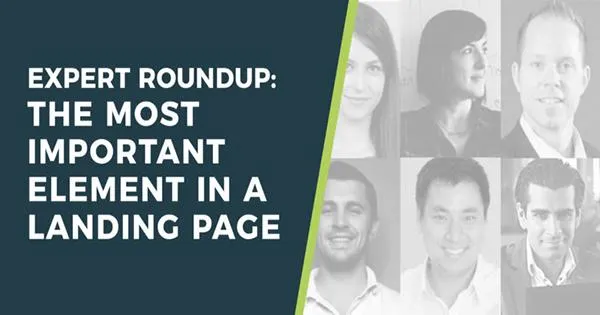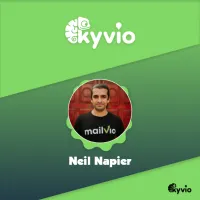Kyvio Blog

8 Experts Share the Secrets to a High Converting Landing Page
Landing pages are an integral part of any business’s online presence. Whether you are trying to build an email list or make more sales, you need a landing page to make it all happen.
A landing page is a doorway into your funnel. It is a special page on your website dedicated to helping your prospects perform a specific action. It could be to download your free lead magnet or to register for your webinar. It could also be a low-cost offer aimed at converting your subscribers into customers.
Regardless of the purpose, a landing page plays a critical role in ensuring your prospects do exactly what you want. But only if you do it right. You see, there are several elements that make a landing page pop.
From the design to the copy, there are several moving parts that need to work together to produce a high-converting landing page. Your pages need to make a great first impression with your prospects. This is especially true if you want to have any chance of moving them further down your funnel.
Every business is different. As a result, there is no one-size-fits-all framework for building the perfect landing page. Still, there are some key elements that will help get your page up and running to a great start.
To have an idea of what these key elements are, we spoke with some of the industry’s top experts. These are conversion rate optimization experts who have tested everything. And today, they are sharing the most important element(s) of a high-converting landing page with you.

Larry Kim – CEO of MobileMonkey, and founder of WordStream, Inc.
“The single most important element in a landing page is having a unique, compelling offer — something that is better than a discount or a trial.
Invest your time in finding out what would really benefit your target audience, and create an offer that gives it to them.
I think too many people get bogged down with choosing fonts, colors, etc.
Really, that’s just page design, and the difference in these kinds of variables will produce negligible if any difference in returns.
Your time will be better spent, and your return greater, by strategically creating an offer they simply can’t not sign up for.
The offer depends on your business. Our clients do Facebook Messenger marketing, so for example, we offer free chatbot templates for Messenger. Figure out the unique offer that will captivate your clients!”

Shane Barker, Digital Strategist, Brand & Influencer Consultant
“Landing pages are increasingly common in digital marketing. Primarily because they help make a good first impression on prospects. A good landing page can help you nail down those prospects and convert them to clients.
But that’s only possible if you’ve optimized your landing pages to have a maximum, lasting impact on visitors. There are multiple elements that you need to consider when optimizing your landing pages. While there isn’t a one-size-fits-all landing page template, there are a few necessary elements you should include.
Some of the most important elements to have on your landing page are:
A catchy headline
Persuasive copy
Engaging media (photos or videos)
Trust factors
A strong call-to-action
Of course, if I had to choose just one of these to focus on, then I think I’d opt for having good, persuasive copy on the page. Writing persuasive copy is crucial to get your point across to your prospects. It should include the benefits of your product, your USP, etc.
Of course, you don’t want to overwhelm your site visitors with too much text. And conversely, too little information and they may not be convinced.
Keep your writing style conversational, and try to avoid using buzzwords like “new” and “innovative.” The important thing to remember is that you want to showcase your value in order to make them take the leap from prospect to customer.”

Joanna Wiebe, Co-founder of Airstory and creator of Copy Hackers.
“The visitor. There’s nothing more important than the visitor and what’s going on in their head when they land on your page. Everything – the offer itself, the headline, the button – depends on that.”

Alex Birkett, Growth Marketing Manager at Hubspot
“I’m not a huge fan of absolutes, especially in the context of conversion optimization, because things are contextual. So on a design level, there’s no “most important element” of a landing page, at least all of the time in all cases for every visitor. Elements above the fold, like the headline and the form, may be more impactful because they’re more visible, but it’s not appropriate to say that’s the case all the time.
There are three variables I usually look at in terms of landing page conversion, though, that you can audit and control for. First, the landing page needs to be usable. As in, visitors need to be able to accomplish the desired task on the page. That means your page needs to be functional, your form should be concise enough where it doesn’t cause massive dropoff, and in general, you should remove friction where possible.
Second, the landing page needs to be relevant. This is usually determined via “message match,” where the language and design of the landing page match the ad the visitor clicked on to get there. This is somewhat of a simplistic way to look at it, but it’s because the moral of the story is right: the landing page should remain relevant to what the visitor is looking for. Finally, the landing page needs to be persuasive. Mostly, this is reminding the visitor of the value of the offer and reducing doubt in their minds about signing up or whatever the goal is.
In my mind all of these 3 elements need to be there for a landing page to be effective, but in order of importance, if I had to say, it would be: ease/usability, relevancy, and then motivation/persuasion.”

Carmen Albisteanu, UX & Conversion Rate Optimization Consultant
“In a landing page, maybe the most important element is the visual clarity and coherence. That is, using the right copy and the right visuals to convey the same message that got the visitor there, and to make it as clear as possible what is expected of him. It means aligning the ads, messages, creatives in the campaign with the content on the landing page. Once there, the visitors will decide in a fraction of a second if it’s worth their time, energy (and eventually money).
We’ve all clicked on banners that said one thing and ended up on landers that said something different. That’s why by keeping the message, color scheme and other elements used in the traffic acquisition you remove the risk of confusion, high bounce rate and, of course, lack of conversions.”

Neil Napier, CEO of Kyvio
“We’ve helped thousands of people build funnels for their business in Kyvio, and through that we’ve learned quite a lot about landing pages. Your landing page is the most important part of your funnel. It’s a decisive stage in your sales. And for those reasons, it’s crucial to spend a lot of time making it perfect.
There are many parts to a landing page that you need to pay attention to. Your design is one of them. The look of your landing page makes the first impression on your visitors. It will decide whether or not they will read the rest of your page. A good layout improve your chances to move your visitors to the next stage, the sale.
Another important element in a landing page is the copy. Visitors have few seconds to decide whether your offer is worth it or not. Your copy plays a huge role in that. You have to make sure your text is clear, compelling and to the point. A confusing copy might easily make your visitors leave.
A final crucial part of your landing page is the Call to Action. Your CTA is what will help you get your users them to take a desired action. Every part of your CTA counts, the color, the size, and especially the text. Make sure to have a seducing CTA that your users wouldn’t be able to resist.
All of these are important components of a landing page. However if I have to choose only one, I would say it’s the offer. If you’re creating a sales funnel, the very first thing you need to think through is your offer. There’s no purpose of creating a gorgeous landing page if your offer doesn’t resonate with your audience. So, for your users, think of what will interest them so much they would give their email for. Your offer should be relevant, valuable and worthy to your audience. That is the decisive part of your landing page.”

Steffan Redhawk, Logicsbest.com
“The most important element in a landing page is the OFFER. Its not hype, or “SIGN UP NOW!”, but the actual offer. Owners of companies are constantly selling themselves short on perceived value. They feel what they have to offer is cheaper somewhere else, or you can buy a chinese knockoff for pennies on the dollar – Or the service isn’t strong enough.
If you do not believe in the strength of your offer – Nobody else will.
Now, you asked for the most important element, but I’m going to give you 2 – Color. Color psychology is what has taken every brand I’ve built from 6 to 7 digits. Businesses reach out to my team when they are stuck in the mid 6 figure range, and we push them over the edge – Its all about the psychology of your prospects – Spend time getting to know your demographic inside and out, or hire a specialist to do it. After that, the only way to market to them, is to know their needs and desires, when that is done, you use the color to appeal only to them, and your conversions skyrocket.”

Christian Martin, christianmartin.org
The first rule of a landing page that converts is to provide something of value to a specific group of people.
Make the value, specific and easy to digest and consume. Think “cheat sheet” instead of “the ultimate guide.”
But wait… What if what you’re offering has already been done before?
Your audience is going to ignore you. Today’s market is a constant competition for attention, the most in demand resource. So how do you capture attention?
Humans are primal creatures and one of the best ways to capture attention is to appeal to base instincts. One in particular works well for landing pages.
Curiosity.
Take these two headlines for example:
Headline #1: How to double conversions on your landing page with better copywriting
Headline #2: The unlikely tactic I learned from David Blane that tripled my landing page conversions and cut my lead costs by 66%… that you can implement in the next ten minutes
These both offer the same thing, but the first is boring, while the second is intriguing, interesting and specific.
Make your headline so intriguing that your visitor can’t fall asleep at night without finding out what you’re offering and watch your conversions soar.”
Landing pages are the most important part of your sales/marketing funnel. They are the turning point of your whole sales process. A good landing page can convert your prospects and turn them into customers. While a poor landing page can make visitors back off or even disassociate from your brand. It’s vital to spend some time on your landing page. If you don’t know where to start you can always come back to what our experts suggested.
A landing page has various parts that should be polished. Our experts have shared the secrets of their own. Make sure to follow their advice.
And you, what do you think is the most important element in a landing page? Share with us your insights we’d love to know what you think.



